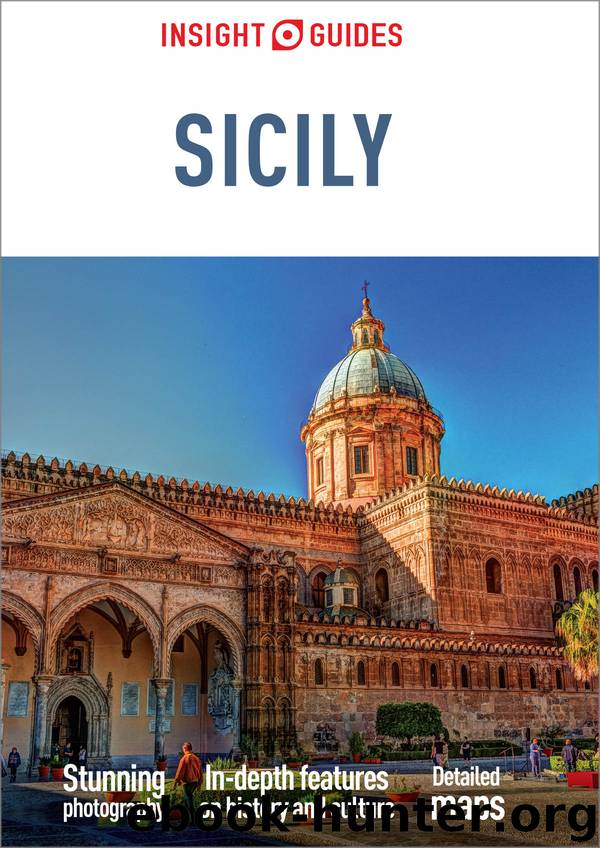Insight Guides Sicily by Insight Guides

Author:Insight Guides
Language: eng
Format: epub
Tags: Travel, Sicily
Publisher: Apa Publications
Published: 2018-11-19T16:00:00+00:00
The lure of quick commissions attracted the finest Greek literary and artistic talents to affluent Sicily. Among them was the founder of Greek tragic drama, the playwright Aeschylus, who died an extraordinary death at Gela in 456 BC. An eagle seized a tortoise and, looking down from a great height for a rock on which to drop and break it, mistook Aeschylus’s bald pate for a polished stone. That was the end of the tragedian.
Gela’s Greek tragedy
Gela was renowned for its entrepreneurial spirit, inspired military architecture and artistic excellence. It became a Doric colony in 688 BC, settled by Greeks from Rhodes and Crete. However, the indigenous Sicani tribe transmuted the superior Greek culture into a unique shape. Exquisite coins, terracotta figurines, sculpted walls, and flourishing agriculture remain a testament to these times. From here, Hellenistic influence spread to the rest of Sicily. Yet Gela was sacked by the Carthaginians in 405 BC, a year after Agrigento’s fall, and was eventually razed by the tyrant of Agrigento in 282 BC, who deported the entire population. Since then, the ancient city has been a symbol of an almost Greek Sicilian tragedy.
There is nothing between Gela’s glorious Greek heritage and today’s grim sprawl. Still it is worth sifting through the industrial debris to reach the ancient city. The walls built by Timoleon, the good tyrant of Siracusa, are set amongst mimosa, eucalyptus and pines; just beyond the sand dunes are futuristic domes and glittering pipes of modern power generation.
The Museo Archeologico (Mon–Sat 9am–7pm), on Corso Vittorio Emanuele, is built alongside the ancient Molino a Vento acropolis, with its recently excavated remains of Hellenistic houses open to inspection. The museum itself displays painted Attic vases, coins, Ionic capitals and terracotta sarcophagi. Gela terracotta was renowned throughout Magna Graecia, prized for its painted designs and the delicacy of the figurative work. The star piece is a noble terracotta horse’s head from the 6th century BC, part of a temple pediment. Parco della Rimembranza, close by, is a park with a single Doric column, the remains of a temple to Athena.
Eat
Download
This site does not store any files on its server. We only index and link to content provided by other sites. Please contact the content providers to delete copyright contents if any and email us, we'll remove relevant links or contents immediately.
Spell It Out by David Crystal(35852)
Underground: A Human History of the Worlds Beneath Our Feet by Will Hunt(11846)
A Year in the Merde by Stephen Clarke(5081)
Venice by Jan Morris(2439)
Claridge's: The Cookbook by Nail Martyn & Erickson Meredith(2260)
My Paris Kitchen: Recipes and Stories by Lebovitz David(2135)
A TIME OF GIFTS by Patrick Leigh Fermor(2103)
The Plantagenets by Dan Jones(1935)
Welcome to the Goddamn Ice Cube by Blair Braverman(1888)
Bang Poland: How To Make Love With Polish Girls In Poland by Roosh V(1862)
Top 10 Prague (EYEWITNESS TOP 10 TRAVEL GUIDES) by DK(1852)
The Finnish Way by Katja Pantzar(1811)
The Isle of Mull by Terry Marsh(1807)
From Russia with Lunch by David Smiedt(1799)
A TIME TO KEEP SILENCE by Patrick Leigh Fermor(1775)
Rick Steves London 2018 by Rick Steves & Gene Openshaw(1752)
A Taste of Paris by David Downie(1747)
Merde in Europe by Stephen Clarke(1672)
Insight Guides Experience Tokyo by Insight Guides(1660)
